Endurance refers to the body's ability to withstand fatigue and remain active whilst under physical strain. Endurance depends largely on the performance of the respiratory and circulatory system as well as the energy management in the muscles, i.e. their ability to convert fat and carbohydrates into energy.(1) This is determined by the number of mitochondria, the number of capillaries in the muscles as well as various metabolic pathways (glycolysis, Krebs cycle and oxidative phosphorylation). Maximal endurance refers to the level of intensity that ranges from the anaerobic threshold to the maximal aerobic exertion. It is determined by the maximal oxygen uptake (VO2max), the biomechanical power of the activity and the performance of the neuromuscular system.
Introduction
Endurance exercise is generally recommended as the basis of all healthy physical exercise. The recommendation is to exercise for at least 2 hours and 30 minutes per week (the common suggestion is five times per week, for at least 30 minutes each time).
Some activities considered to fall under endurance exercise include walking, cycling, swimming, hiking and even heavier house and yard work. The intensity varies depending on the individual's fitness level. To make significant developments in one's endurance fitness, it is usually necessary to include activities more arduous than walking, for example running, cross-country skiing, fast-paced cycling or various ball games. In terms of group exercise, various aerobics, dance, and cross-training classes are popular.
Endurance exercise can be divided into four types by the level of exertion involved: basic aerobic endurance, tempo endurance, maximal endurance and speed endurance. Endurance can also be divided into either aerobic or anaerobic exercise. In practice, basic aerobic endurance is the basis of all movement.
The boundary between basic endurance and tempo endurance is called the aerobic threshold. Similarly, the boundary between tempo endurance and maximal endurance is called the anaerobic threshold. Anaerobic (oxygen-free) energy production increases with the level of physical effort. The aerobic threshold is the level of effort at which anaerobic energy pathways start to be a significant part of energy production (usually under 70 % of the maximal heart rate).(2)
The anaerobic threshold is defined as the level of exercise intensity at which lactic acid builds up in the body faster than it can be cleared away by the heart, liver and striated muscles. For this reason, it is also sometimes called the lactate threshold (approximately 85–90 % of the maximal heart rate). Once the threshold has been surpassed, more lactic acid is produced in the muscles than can be removed, slowly leading to fatigue.(3) Both aerobic and anaerobic threshold may be increased by training. For example, runners want to increase their aerobic threshold because this will enable them to run faster for longer.
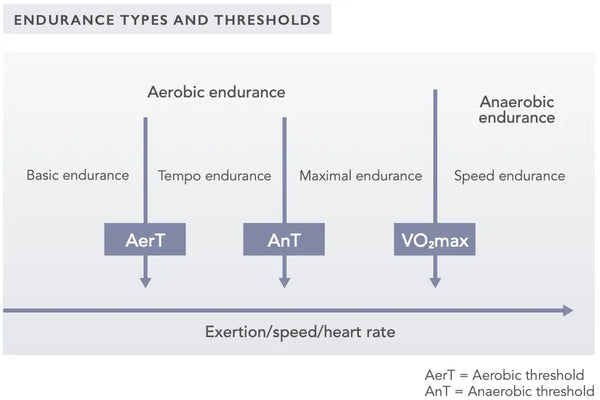
The indicative threshold values can be determined using the Karvonen formula:
(Maximal heart rate – resting heart rate) x desired heart rate zone between 60–90 % + resting heart rate
For example (189 – 50) x 0.7 + 50 = 147 (the estimated aerobic threshold for a 35-year-old individual with a resting heart rate of 50 bpm).
The most accurate method of estimating the maximal heart rate (HRmax) is to use the following formula:(4)
211 – 0.64 x age in years (for example 211 – 0.64 x 35 = 189)
A 2022 study saw the lowest mortality risk at a VO2 max of 49 ml/kg/min with no increase in risk with high cardiorespiratory fitness.(5) The least fit individuals had a 4x higher mortality risk than the extremely fit ones. Smoking typically increases mortality risk by 2-3x – smoking combined with obesity does so by 3.5-5x. This means that having low cardiorespiratory fitness and low VO2 max is one of the most significant lifestyle risk factors for increased mortality and shorter lifespan. It is almost as important as not smoking, if not even more important.
The Benefits of Endurance Exercise
Endurance exercise has both functional and structural benefits. Structural changes include increases in heart volume and muscular strength, lung volume, number of mitochondria and microvasculature. Functional changes include lower blood pressure at rest, lower resting heart rate, increased heart stroke volume and cardiac output, and improved oxygen uptake.(6)
Endurance exercise is known to have a positive impact on anxiety and depression, balancing stress and the treatment and prevention of numerous chronic illnesses.
It is also known to reduce the risk of cardiovascular diseases. It appears that to achieve these benefits, just three months of moderate training (2–3 hours per week) is required, after which further benefits are limited even if there is an increase in the amount or intensity of training.(7) Moderate exercise (MET <6) seems to be the best predictor of longevity and general good health.(8)
The Basic Principles of Endurance Training
The main goal of endurance training is to increase the body's ability to perform prolonged exercises ranging in duration from a few minutes to several hours. Typical sports include walking, running, cycling, cross-country skiing, swimming and hiking.
Developing endurance usually requires training at least three times per week, for 30 to 60 minutes at a time. Utilizing heart rate zones and training with a heart rate monitor can be useful. However, this is not strictly necessary – the method helps you recognize various heart rate zones and their physiological impact on endurance training.
Key factors in endurance exercise:
- The majority of endurance training takes place in the basic endurance zone (approx. 70–80 % of the training session). This develops basic endurance in general and cardiac output in particular
- Focus on technique training
- Training should be progressive in nature and there should be sufficient time reserved for recovery
- High intensity interval training (HIIT) is particularly effective for increasing the number of mitochondria and the maximal oxygen uptake (VO2max)(9-10)
- Perform various interval exercises in the tempo and maximal endurance zones
- Short intervals (HIIT); 15–45 second exercise intervals, rest for 15 seconds to 3 minutes
- Long intervals; 3–8 minute exercise intervals, rest for 1minute to 4 minutes
- Incremental intervals; 8–20 minute exercise intervals,varying rest intervals. The intensity is even lower than in the long interval training
- Strength training increases the effectiveness of endurance exercise and improves performance(11)
- Perform restorative exercises and avoid overtraining
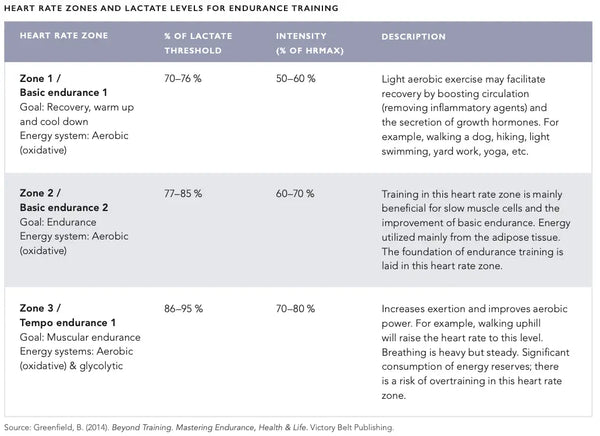
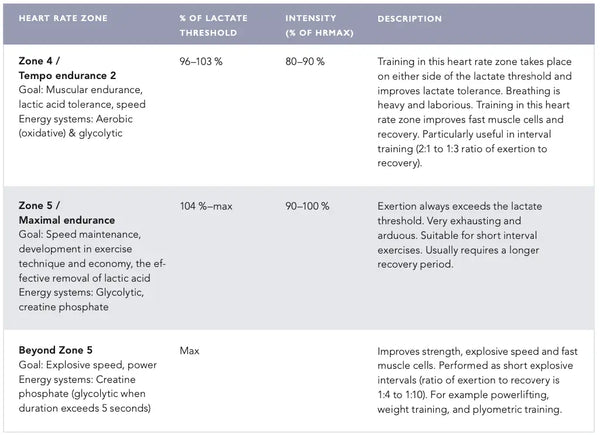
HOW TO UTILIZE HEART RATE ZONES IN TRAINING?
- If your endurance fitness level is good but you get fatigued as soon as your muscles start producing lactic acid, you should add intervals in heart rate zone 4
- If intervals pose no problem but you get fatigued during prolonged exercises performed at a steady pace, you should add exercises in heart rate zone 2 and intervals in zone 3
- If you can’t sprint to the finish at the end of a 5 kilometer run, you should add intervals in heart rate zone 5 (maximal endurance)
- If your body is slow to recover, add exercises in heart rate zone 1
Do 2-3x Zone 2 cardio weekly workouts for 30-60 minutes per workout (depending on your current fitness level; start low and build up). Zone 2 is a steady state low-intensity heart rate zone between 60-70% of maximum heart rate. It is low intensity enough to maintain nasal breathing and even talk. Zone 2 lays the foundation for cardiorespiratory fitness. Having a solid foundation with Zone 2 that builds slow twitch muscle fibers and increases the number of mitochondria improves one's overall cardiorespiratory fitness.
One should also do interval training one to two times per week.
The type of interval training can vary between how much time one has and how one feels. For example, 1-minute sprints at maximum effort followed by 1 minute rest and repeated for eight rounds. Another great option is 3–4-minute maximum sprints followed by 4 minutes of rest and repeated for four rounds.
Dr. Olli Sovijärvi's favorite interval or HIIT session is called the Gibala Mehthod, which is based on a 2010 study conducted on students, published by Martin Gibala, a doctor of physiology. The goal of the study was to determine the effect of high intensity (100 % VO2max) interval training on general performance using a method that is safer and of slightly lower intensity than the Tabata method.
The study continued for two weeks during which six stationary bike workouts were completed. Each workout included a 3-minute warm-up phase followed by the interval phase: 60 seconds of action followed by 75 seconds of rest, repeated 8–12 times. There was no control group involved in the study. Gibala found out that this method achieved the same oxygen uptake benefits as 5 hours of constant pace endurance training per week. The method also significantly increased the force generation capability of muscle cells and improved sugar metabolism.(12)
A 2019 meta-analysis of 53 studies found that short-intervals (≤30s), low-volume (≤5min), and short-term (≤ 4 weeks) are an effective and time-efficient ways to increase VO2 max. However, they found that to maximize VO2 max adaptations, long-interval (≥2min), high-volume (≥15min) and moderate to long-term (≥4-12weeks) are better.(13) So, more and longer intervals are generally superior to short and low-volume intervals. However, the short intervals are also effective if one lacks time.
- Training at the same intensity level and heart rate zone time after time
- Training at the same pace time after time
- Training too hard on lighter training days or vice versa
How to Measure Aerobic Fitness and Oxygen Uptake (VO2max)
Measuring and testing athletes began after the first official Olympic games (1886). The first bicycle ergometer was built in Denmark in 1910. The concept of maximal oxygen uptake was developed in 1920 by physiologist Archibald Hill (1886–1977).(14) However, it was not until the 1960s that comprehensive studies regarding maximal oxygen uptake testing were published.(15-16)
OXYGEN UPTAKE
Oxygen uptake refers to the ability of the respiratory and circulatory system to transport oxygen and the ability of the muscles to use
it for energy production. Maximal oxygen uptake (VO2 max) refers to the oxygen uptake occurring under extreme stress. The terms oxygen uptake and oxygen consumption are often used interchangeably. Maximal oxygen uptake is expressed either as an absolute value (liters per minute) or more commonly as a relative value of liters per minute per kilogram of bodyweight (ml/kg/min). Oxygen uptake is indicative of endurance fitness which can be improved with regular endurance or interval training. The highest maximal oxygen uptake values have been measured for cyclists and skiers.(17)
UKK WALK TEST
The scientifically validated UKK walk test was developed in Finland in the early 1990s for the purpose of measuring endurance fitness, i.e. the performance of the respiratory and circulatory system.(18) The walk test is intended especially for the study of the physical fitness of middle-aged people. However, it can also be applied to other age brackets or overweight individuals.(19-20)
The test involves walking 2 kilometers on a level surface as fast as possible. A fitness index is then calculated based on the time spent walking, the heart rate at the end of the test, body mass index, and sex. The test subject's maximal oxygen uptake is estimated based on the test results. Adequate accuracy is achieved when the heart rate at the end of the test is at least 80 % of maximum heart rate.(21) The test is not generally recommended for individuals of very high fitness levels as it is not sufficiently strenuous in these cases.(22)
The UKK walk test formula for estimating maximal oxygen uptake: The result is VO2max (ml/min/kg)
Men:
184.9 – 4.65 x (time in minutes) – 0.22 x (heartbeat) – 0.26 x (age) – 1.05 x (BMI)
Women:
116.2 – 2.98 x (time in minutes) – 0.11 x (heartbeat) – 0.14 x (age) – 0.39 x (BMI)
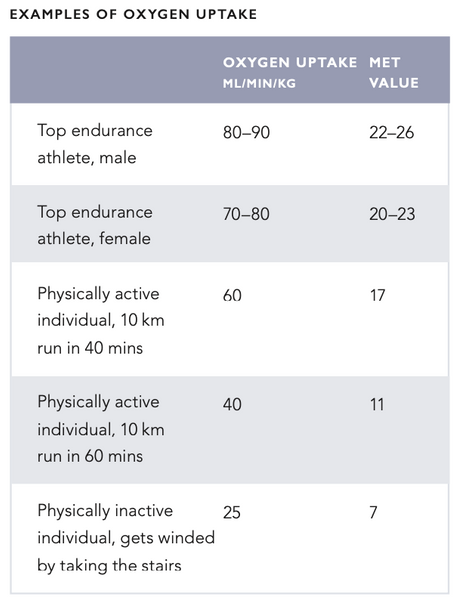
CLINICAL EXERCISE STRESS TEST USING A BICYCLE
A clinical exercise stress test (exercise ECG) is usually conducted using a stationary bicycle (exercise ergometer) under the supervision of a doctor.
The test is offered by many medical clinics. Stress tests are also often conducted to study potential cardiovascular diseases. It is particularly common when diagnosing coronary heart disease. For the biohacker, a clinical exercise stress test using a bicycle is a good means of measuring aerobic fitness and anaerobic force generation, as long as the test is performed to absolute exhaustion.
Arterial blood oxygen level and lung function may also be measured during the test. Athletes usually undergo more comprehensive testing, i.e. running spiroergometry (see paragraph below). The doctor may interrupt the stress test if something unusual is detected in the symptoms, electrocardiogram, blood pressure, blood oxygen saturation, or other variables.(23)
The exercise stress test is usually initialized with low resistance (40 W for women, 50 W for men). The test is typically conducted with three-minute intervals between additions to resistance. For women, the increments in resistance are 40 W each, for men they are 50 W each. The pace is usually 60–70 rpm. Perceived exertion is assessed during the exercise stress test using the Borg scale. The objective of the exercise stress test is to achieve the perceived exertion rating of 90 % of maximum within 6–12 minutes by increasing the resistance level. For individuals of very high fitness, the time required may be significantly longer. Maximal oxygen uptake may be estimated based on the test results. However, for athletes, the accuracy is not sufficient when the performance is submaximal.(24-25)
-
Cycle Ergometer (YMCA) Protocol calculator (read instuctions in the link)
RUNNING SPIROERGOMETRY
Spiroergometry is the extended version of the clinical exercise stress test, intended especially for athletes. It is conducted using either a bicycle ergometer or treadmill. In addition to the analytical methods of the clinical exercise stress test, this test involves measuring respiratory gases and the tidal volume.The test allows for the direct measurement of oxygen consumption and carbon dioxide production and therefore the anaerobic threshold. The more comprehensive version can also involve measuring the lactic acid level in arterial blood.
The test subject pedals the bicycleergometer or runs on the treadmill, with incremental increases to resistance, either to submaximal or complete exhaustion. The respiratory gases are measured using a mask secured to the test subject's face.
Spiroergometry can accurately determine an individual's maximal oxygen consumption (oxygen uptake) and anaerobic threshold. This is the point where carbon dioxide production begins to increase compared to oxygen consumption and lactic acid begins to form in the blood. At the same time, the breathlessness level is significantly increased. Spiroergometry is the golden standard when it comes to studying performance-impairing factors related to respiration, the cardiovascular system, metabolism, etc. The spiroergometry test is also widely used to assess an individual’s ability to work.(26)
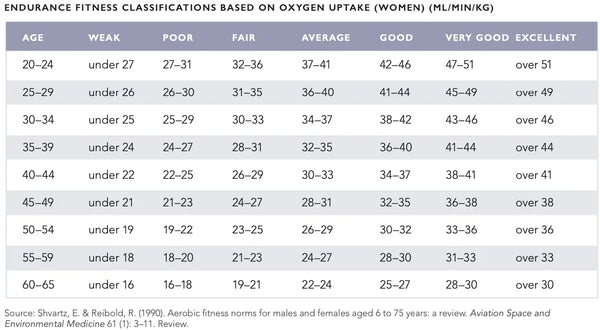
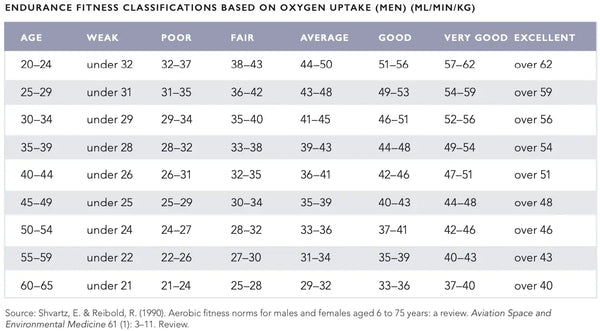
COOPER TEST
The Cooper test, developed by Dr. Kenneth H. Cooper in 1968 for the United States army, is used for the assessment of maximal endurance. It involves running as far as possible in 12 minutes. According to studies, a strong correlation exists between the Cooper test results and maximal oxygen uptake.(27) The test is best suited for runners as it utilizes running economy and technique.
Here is the Cooper test calculator for estimating your VO2max.
Wearable Tech for Testing VO2max
Wearable technology has become increasingly popular for measuring various fitness parameters, including VO2max. However, it is crucial to understand the accuracy of these measurements compared to the gold standard VO2max testing conducted in clinical or laboratory settings.
Wearable devices, such as fitness trackers and smartwatches, estimate VO2max using algorithms that consider heart rate data, with other factors such as age, gender, physical activity levels, and sometimes GPS data for outdoor workouts. They use proprietary algorithms to estimate VO2max based on the relationship between heart rate and oxygen consumption, which can vary among individuals. The accuracy of the estimates can be influenced by several factors, including the precision of the heart rate sensor, the algorithm's ability to account for individual variations and the conditions under which the data is collected (e.g., steady-state versus variable intensity exercise).(28)
Studies have shown varying degrees of accuracy when comparing wearable technology to the gold standard spiroergometry. Many wearable devices provide reasonably good estimates of VO2max for general population use, especially for individuals with moderate fitness levels. However, they may need to be more accurate for highly trained athletes or individuals with specific health conditions. The degree of error can vary depending on the brand and model of the device, as well as on the user's specific characteristics and exercise patterns.(29)
Wearable technology is best used to track changes over time and provide a general estimate of cardiovascular fitness.
Waearbles that measure VO2max:
-
Select Garmin devices automatically estimate your VO2 max each time you record a run or brisk walk with heart rate and GPS tracking activated. Over the course of your activity, the Firstbeat Analytics engine built into your device examines the relationship between how fast you’re moving and how hard your body is working to maintain that pace.
- Polar watches (like Pacer & Polar Vantage)
- The Polar Fitness Test with wrist-based heart rate is an easy, safe and quick way to estimate your aerobic (cardiovascular) fitness at rest. It's a simple 5-minute fitness level assessment that gives you an estimate of your maximal oxygen uptake (VO2max). The Fitness Test calculation is based on your resting heart rate, heart rate variability and your personal information: gender, age, height, weight, and self-assessment of your physical activity level called the training background. The Polar Fitness Test is developed for use by healthy adults.
- Fitbit watches and bands
- If you own a Fitbit Alta HR, Fitbit Charge 2, Fitbit Blaze, or Fitbit Ionic you have access to your Cardio Fitness Score, a unique Fitbit feature that estimates your VO2 max—a measure of how well your body uses oxygen during strenuous exercise.
Calculators for testing VO2max
VO2 max calculator is intended for every sportsperson who wants to find their maximal aerobic capacity value. This parameter is crucial in any endurance sport and allows one to train effectively and adequately. In the article on this page, we prepared some brief information about what VO2 max is, how to calculate VO2 max, a description of VO2 max tests, and an explanation of how to use this aerobic capacity calculator.
Testing methods that apply for the calculator:
- Resting heart rate (RHR)
- 1 mile walk test
- 3 minutes step test
- 1.5 mile walk/run test
- Best 2000m rowing time (indoor rower)
Conclusion
In summary, improving VO2max through endurance training is a primary intervention tactic for better general health and longer life. Studies further showed that the efficient control of respiratory system performance, circulatory system flows and muscle energy transformation processes played a pivotal role in this improvement. Cardiovascular fitness is only increased through essential aerobic exercises and intense maximal endurance workouts, constituents of endurance training. Knowledge and practice of heart rate zones in the training program provide a customized exercise method, which is more effective because it meets the current fitness level and needs.
Technological progress in evaluating VO2max, from classic tests such as spiroergometry to modern wearable devices, provides viable scientific information on cardiovascular well-being. Nevertheless, it is essential to realize that wearable gadgets are imperfect devices compared to clinical values and may only be beneficial in tracking trends. A consistent and comprehensive endurance training routine should be supported with the necessary insurance conditions off-field. In that case, it will increase cardiovascular performance, eliminating crucial risks associated with low cardiorespiratory fitness.
Scientific References
- Ghosh, A. (2004). Anaerobic threshold: its concept and role in endurance sport. The Malaysian Journal of Medical Sciences 11 (1): 24-36.
- Ivy, J. & Withers, R. & Van Handel, P. & Elger, D. & Costill, D. (1980). Muscle respiratory capacity and fiber type as determinants of the lactate threshold. Journal of Applied Physiology 48 (3): 523–527.
- Nes, B. & Janszky, I. & Wisløff, U. & Støylen, A. & Karlsen, T. (2013). Age-predicted maximal heart rate in healthy subjects: The HUNT fitness study. Scandinavian Journal of Medicine and Science in Sports 23 (6): 697–704.
- Kokkinos, P. et al. (2022). Cardiorespiratory fitness and mortality risk across the spectra of age, race, and sex. Journal of the American College of Cardiology 80 (6): 598-609.
- McArdle, W. & Katch, F. & Katch, V. (2014). Exercise Physiology. Nutrition, Energy and Human Performance. 8th Edition. Philadelphia: LWW.
- Iwasaki, K. & Zhang, R. & Zuckerman, J. & Levine, B. (2003). Dose-response relationship of the cardiovascular adaptation to endurance training in healthy adults: how much training for what benefit? Journal of Applied Physiology 95 (4): 1575–1583.
- Lee, I. & Hsieh, C. & Paffenbarger, R. Jr. (1995). Exercise intensity and longevity in men. The Harvard Alumni Health Study. JAMA (15): 1179–1184.
- Helgerud, J. et al. (2007). Aerobic high-intensity intervals improve VO2max more than moderate training. Medicine and Science in Sports and Exercise 39 (4): 665–671.
- Burgomaster, K. et al. (2008). Similar metabolic adaptations during exercise after low volume sprint interval and traditional endurance training in humans. Journal of Physiology 586 (1): 151–160.
- Rønnestad, B. & Mujika, I. (2014). Optimizing strength training for running and cycling endurance performance: A review. Scandinavian Journal of Medicine and Science in Sports 24 (4): 603–612.
- Little, J. & Safdar, A. & Wilkin, G. & Tarnopolsky, M. & Gibala, M. (2009). A practical model of low-volume high-intensity interval training induces mitochondrial biogenesis in human skeletal muscle: potential mechanisms. Journal of Physiology 588 (Pt 6): 1011–1022.
- Wen, D. et al. (2019). Effects of different protocols of high intensity interval training for VO2max improvements in adults: A meta-analysis of randomised controlled trials. Journal of SciencM and medicine in Sport 22 (8): 941-947.
- Seiler, S. (2011). A brief history of endurance testing in athletes. Sportscience 15: 40–86.
- Taylor, H. & Buskirk, E. & Henschel, A. (1955). Maximal oxygen intake as an objective measure of cardio-respiratory performance. Journal of Applied Physiology 8 (1): 73–80.
- Åstrand, P & Saltin, B. (1961). Maximal oxygen uptake and heart rate in various types of muscular activity. Journal of Applied Physiology 16: 977–981.
- Bassett, D. & Howley, E. (2000). Limiting factors for maximum oxygen uptake and determinants of endurance performance. Medicine and Science in Sports and Exercise 32 (1): 70-84.
- Rance, M. et al. (2005). Validity of a VO2 max prediction equation of the 2-km walk test in female seniors. International Journal of Sports Medicine 26 (6): 453–456.
- Oja, P. & Laukkanen, R. & Pasanen, M. & Tyry, T. & Vuori, I. (1991). A 2-km walking test for assessing the cardiorespiratory fitness of healthy adults. International Journal of Sports Medicine 12 (4): 356–362.
- Laukkanen, R. & Oja, P. & Pasanen, M. & Vuori, I. (1992). Validity of a two kilometre walking test for estimating maximal aerobic power in overweight adults. International Journal of Obesity Related Metabolic Disorders 16 (4): 263–268.
- Laukkanen, R. & Oja, P. & Pasanen, M. &. Vuori, I. (1993). A two-kilometer walking test: effect of walking speed on the prediction of maximal oxygen uptake. Scandinavian Journal of Medicine and Science in Sports 3 (4): 263–266.
- Laukkanen, R. & Oja, P. & Pasanen, M. &. Vuori, I. (1993). Criterion validity of a two-kilometer walking test for predicting the maximal oxygen uptake of moderately to highly active middle-aged adults. Scandinavian Journal of Medicine and Science in Sports 3 (4): 267–272.
- Fletcher, G. et al. (2013). American Heart Association Exercise, Cardiac Rehabilitation, and Prevention Committee of the Council on Clinical Cardiology, Council on Nutrition, Physical Activity and Metabolism, Council on Cardiovascular and Stroke Nursing, and Council on Epidemiology and Prevention. Exercise standards for testing and training: a scientific statement from the American Heart Association. Circulation 128 (8): 873–934.
- Smith, A. & Evans, H. & Parfitt. G. & Eston, R. & Ferrar, K. (2016). Submaximal Exercise-Based Equations to Predict Maximal Oxygen Uptake in Older Adults: A Systematic Review. Archives of Physical Medicine and Rehabilitation 97 (6): 1003–1012.
- Evans, H. & Ferrar, K. & Smith, A. & Parfitt, G. & Eston, R. (2015). A systematic review of methods to predict maximal oxygen uptake from submaximal, open circuit spirometry in healthy adults. Journal of Science in Medicine and Sport 18 (2): 183–188.
- Piirilä, P. & Sovijärvi, A. (2013). Spiroergometry in the assessment of exercise capacity and associated restrictive factors. Duodecim; Laaketieteellinen Aikakauskirja 129 (12):1251-1261.
- Grant, S. & Corbett, K. & Amjad, A. & Wilson, J. & Aitchison, T. (1995). A comparison of methods of predicting maximum oxygen uptake. British Journal of Sports Medicine 29 (3): 147–152.
- Neshitov, A. et al. (2023). Estimation of cardiorespiratory fitness using heart rate and step count data. Scientific Reports 13 (1): 15808.
- Shei, R. & Holder, I. & Oumsang, A. & Paris, B. & Paris, H. (2022). Wearable activity trackers–advanced technology or advanced marketing? European Journal of Applied Physiology 122 (9): 1975-1990.





